- St. Stephen Harding
Feast date: Apr 17
St. Stephen Harding is regarded as the founder of the Cistercian monasteries. He was born in Dorset, England, and educated at Sherborne Abbey.
After studying in Paris and Rome, he visited the monastery of Molesme. Impressed by its holy abbot, Robert of Molesme, and the prior, Alberic (both of which were later canonized), Stephen joined the community.
After a few years, the three men, along with 20 other monks, established a more austere monastery in Citeaux. Eventually Robert was called back to his position of abbot at Molesme(1099), and Alberic, who became the new abbot of Citeaux, died in 1110. Following Alberic’s death, Stephen was elected as abbot.
Stephen drew up the famous “Charter of Charity,” which became the basis for Cistercian monasticism. However, very few men were joining the community and the monastery was suffering from hunger and sickness. It seemed for awhile as if thier new order was destined to die out. However, in1112 the man who was to be known as St. Bernard of Clairvaux, joined the community along with 30 other companions, including almost his entire family. The very next year Stephen founded his first colony at La Ferté.
Before his death in 1134, Stephen had established 13 monasteries. By the end of the 12th century there were 500 in Europe.
- St. Bernadette Soubirous of Lourdes
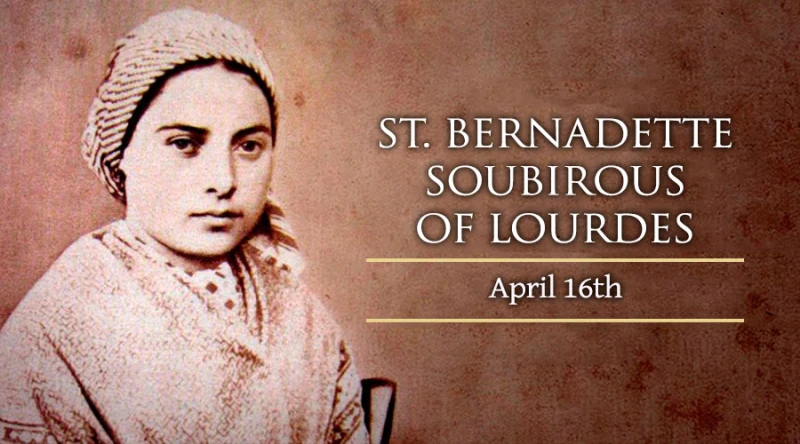
St. Bernadette Soubirous of LourdesFeast date: Apr 16
St. Bernadette Soubirous is the renowned visionary of Lourdes. She was born into a poor family in Lourdes, France, in 1844 and was baptized with the name Mary Bernard.
Our Lady first appeared to the 14-year-old Bernadette on Feb. 11, 1858, in a cave on the banks of the Gave River near Lourdes. The visions continued for a period of several weeks. Two weeks after the first appearance of Our Lady, a spring emerged from the cave, and the waters were found to miraculously heal the sick and the lame. One month later, on March 25, the woman whom Bernadette had been seeing told her that her name was “the Immaculate Conception”, and that a chapel should be built on the site of the apparitions.
Civil authorities tried to frighten Bernadette into retracting her accounts, but she remained faithful to her visions. They also tried to shut down the spring and delay the construction of the chapel, but Empress Eugenie of France intervened when her child was cured with the water from the spring, and the church was built.
In 1866, Bernadette entered the Sisters of Notre Dame in Nevers. She was diagnosed with a painful, incurable illness soon afterward and died in 1879 at the age of 35. Pope Pius XI canonized her in 1933.
- St. Oswald
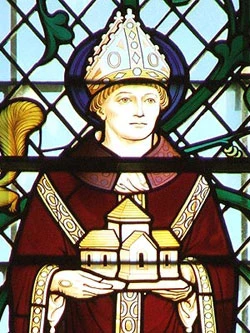
St. OswaldFeast date: Feb 29
St. Oswald was a king of Northumbria from 634 until his death and is venerated as a saint.
Oswald spread the Christian faith throughout Northumbria. He had a cult following, and was generous with the poor.
There are many legends surrounding his reign.
- Our Lady of Guadalupe
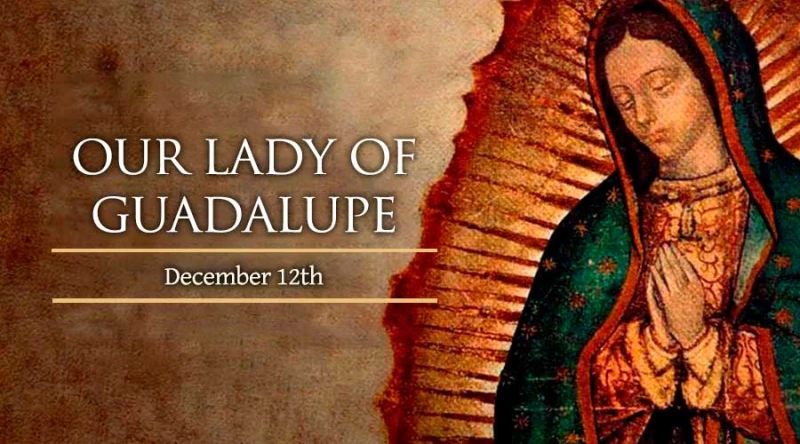
Our Lady of GuadalupeFeast date: Dec 12
In 1531 a “Lady from Heaven” appeared to Saint Juan Diego, a poor Indian from Tepeyac, a hill northwest of Mexico City. She identified herself as the Mother of the True God and instructed him to have the bishop build a church on the site. As a sign for the bishop, she left an image of herself imprinted miraculously on his tilma, a poor quality cactus-cloth. The tilma should have deteriorated within 20 years but shows no sign of decay after over 470 years. To this day it defies all scientific explanations of its origin.
In the eyes of Our Lady of Guadalupe on the tilma, we can see reflected what was in front of her in 1531. Her message of love and compassion, and her universal promise of help and protection to all mankind, as well as the story of the apparitions, are described in the “Nican Mopohua,” a 16th century document written in the native Nahuatl language.
There is reason to believe that at Tepeyac Mary came in her glorified body, and her actual physical hands rearranged the roses in Juan Diego’s tilma, which makes this apparition very special.
An incredible list of miracles, cures, and interventions are attributed to Our Lady of Guadalupe. Each year an estimated 10 million people visit her Basilica, making her Mexico City home the most popular Marian shrine in the world, and the most visited Catholic church in the world after Saint Peter’s Basilica in the Vatican.
Science cannot explain the tilma, to this day.
There is no under sketch, no sizing and no protective over-varnish on the image. Microscopic examination revealed that there were no brush strokes. The image seems to increase in size and change colors due to an unknown property of the surface and substance of which it is made. According to Kodak of Mexico, the image is smooth and feels like a modern day photograph. Produced 300 years before the invention of photography.) The image has consistently defied exact reproduction, whether by brush or camera. Several images can be seen reflected in the eyes of the Virgin. It is believed to be the images of Juan Diego, Bishop Juan de Zummaraga, Juan Gonzales-the interpreter and others.The distortion and place of the images are identical to what is produced in the normal eye, which is impossible to obtain on a flat surface. The stars on Our Lady’s Mantle coincide with the constellation in the sky on December 12, 1531. All who have scientifically examined the image of Our Lady over the centuries confess that its properties are absolutely unique and so inexplicable in human terms that the image can only be supernatural.
Altogether 24 popes have officially honored Our Lady of Guadalupe. His Holiness Blessed John Paul II visited her Sanctuary four times: on his first apostolic trip outside Rome as Pope in 1979, and again in 1990, 1999 and 2002.
The Feast of Our Lady of Guadalupe is celebrated on December 12th. In 1999, Blessed John Paul II, in his homily given during the Solemn Mass at the Basilica of Our Lady of Guadalupe, his third visit to the sanctuary, declared the date of December the 12th as a Liturgical Holy Day for the whole continent. During the same visit Pope John Paul II entrusted the cause of life to her loving protection, and placed under her motherly care the innocent lives of children, especially those who are in danger of not being born.
Patronage: Americas, Central America, diocese of Colorado Springs Colorado, diocese of Corpus Christi Texas, diocese of Dodge City, Kansas, Estremadura Spain, diocese of Gallup New Mexico, Mexico, diocese of Nashville Tennessee, New Mexico, New World, diocese of Orange California, diocese of Phoenix Arizona, Puerto Vallarta, Mexico, diocese of Sacramento, California, diocese of Sioux City Iowa, Spain.
- St. Gianna Beretta Molla

St. Gianna Beretta MollaFeast date: Apr 28
Gianna Beretta Molla was born on October 4, 1922 in Magenta, Italy. She was the tenth of 13 children in her family. She grew up in a devout Catholic home and quickly learned the value of prayer. As a young adult, she joined the Society of Saint Vincent de Paul.
Gianna began to study medicine during World War II. In 1950 she opened her own medical office in Mesero, which was near her hometown. A couple years later she began to specialize in pediatrics and was drawn towards mothers, babies, the elderly, and the poor.
In 1954 Gianna met Pietro Molla, an engineer who worked in her office. In September of 1955 the two became husband and wife. Between 1956 and 1959 the couple had three children, Pierluigi, Maria Zita and Laura.
Gianna embraced the vocation of being a wife and mother with all her being and completely dedicated herself to “forming a truly Christian family.”
In 1961, Gianna became pregnant with their fourth child. It was during this pregnancy that doctors discovered that Gianna had developed a uterine tumor.
The doctors gave her three choices: an abortion, which would save her life and allow her to have more children but take the life of her baby; a complete hysterectomy, which would save her life but prevent her from having more children and take her baby’s life; or removal of the fibroma only, which posed the risk of future complications but could save the life of her baby.
Gianna chose to have only the tumor removed. She was willing to lose her life for the sake of her baby’s. She knew that she may not make it through delivery, but she made it very clear that if a choice needed to be made between saving her own life or the child’s, the child needed to be saved.
Throughout her pregnancy, Gianna found strength in the Lord and asked him to take any pain away from the child.
On April 21, 1962 Gianna Emmanuel Molla was successfully delivered by Cesarean section. However, after complications arose with the tumor, Gianna passed away 7 days later on April 28.
Gianna was beatified by Saint Pope John Paul II on April 24, 1994 and canonized as a saint on May 16, 2004. Her husband and children attended her canonization.
During her canonization, Saint Pope John Paul II said, “Shortly before her wedding, in a letter to her future husband, she wrote: “Love is the most beautiful sentiment that the Lord has placed in the spirit of men.”
“Following the example of Christ, who ‘having loved his own … he loved them to the end’ (John 13:1) this holy mother of a family was heroically faithful to the commitment she took on the day of her marriage. The supreme sacrifice that sealed her life testifies that only the one who has the courage to give himself totally to God and to neighbor finds fulfillment,” he added.
The pope described her as, “a simple, but more than ever, significant messenger of divine love.”
St. Gianna Beretta Molla is the patron saint of mothers, physicians, and unborn children.
- St. Stanislaus
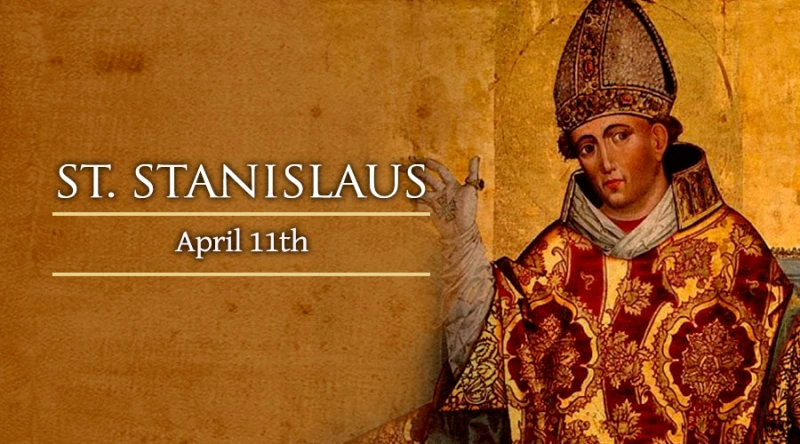
St. StanislausFeast date: Apr 11
On April 11, the Catholic Church honors the memory of the 11th-century bishop and martyr St. Stanislaus of Krakow, who died for the faith at the hands of King Boleslaus II.
Canonized in 1253, St. Stanislaus is a beloved patron of the Polish nation and people. In his own country he is commemorated May 8, the date of his death in 1079.
Blessed John Paul II – who was Krakow’s archbishop in the “See of St. Stanislaus” before becoming Pope – paid tribute to him often during his pontificate. In a 2003 letter to the Polish Church, he recalled how St. Stanislaus “proclaimed faith in God to our ancestors and started in them…the saving power of the Passion and Resurrection of Jesus Christ.”
“He taught the moral order in the family based on sacramental marriage. He taught the moral order within the State, reminding even the king that in his actions he should keep in mind the unchanging Law of God.” Through St. Stanislaus, God taught the Polish Pope’s homeland to respect “the Law of God and the just rights of every person.”
Born near Krakow in July of 1030, Stanislaus Szczepanowski was the son of Belislaus and Bogna. His parents, members of the nobility, showed great zeal and charity in their practice of the Catholic faith. Their son studied for a time in his own country, and went on to learn theology and canon law in Paris. The death of his parents left him with a large inheritance, which he gave away to the poor.
After his ordination to the priesthood, Stanislaus served Church of Krakow in different pastoral and administrative posts. Following the death of the diocese’s leader, Bishop Lambert Zula, Stanislaus was chosen as his successor in 1071. He did not want the position, but obeyed Pope Alexander II’s order to accept it. Having done so, he proved to be a bold preacher of the Gospel.
This boldness brought him into conflict with Poland’s ruler, King Boleslaus II, who was becoming notorious for his violent and depraved lifestyle. After a series of disputes over his scandalous behavior and other matters, Stanislaus found no success in his efforts to reform the king.
He excommunicated the sovereign – who responded with furious anger, sending henchmen to kill the bishop. When they proved unwilling or unable to do so, Boleslaus took matters into his own hands. He ambushed Stanislaus and struck him down with a sword during his celebration of Mass.
St. Stanislaus was soon acclaimed as a martyr, while Boleslaus II lost his grip on power and left Poland. In later years the fallen monarch is said to have lived in a monastery, repenting of the murder.
- St. Fulbert
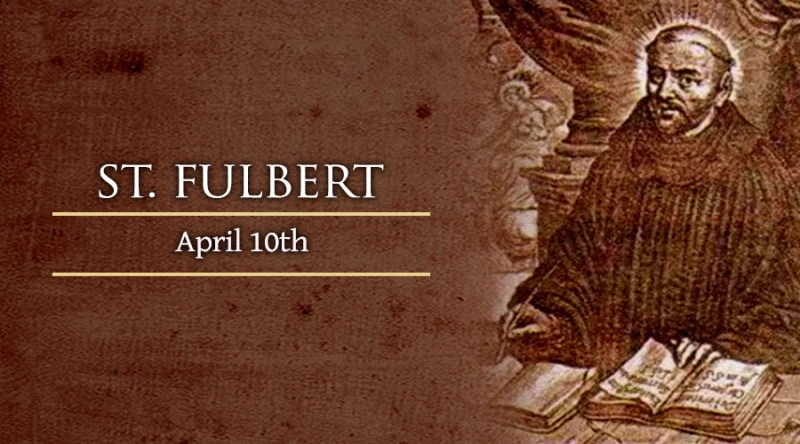
St. FulbertFeast date: Apr 10
St. Fulbert was a scholar and philosopher, and was also the bishop of Chartres, France. He spent much of his time as bishop rigorously defending monasticism and orthodoxy.
He was born in Italy in the 10th century and studied at Rheims, France, under the celebrated philosopher Gerbert, who later became Pope Sylvester II. Gerbert took Fulbert to Rome with him. After the Pope’s death, the bishop of Chartres made Fulbert the chancellor of the cathedral, and soon Chartres became one of the best learning centers in France.
He was eventually named bishop of Chartres in 1007 and had the cathedral rebuilt after a fire destroyed it. He died in 1029.
- St. Waudu
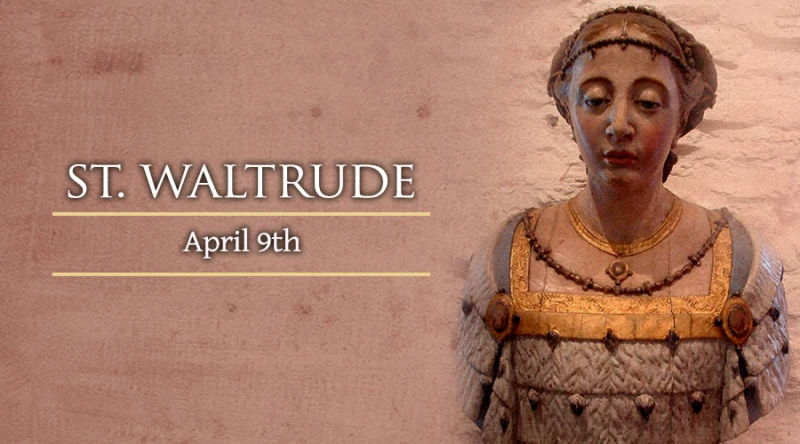
St. WauduFeast date: Apr 09
St. Waudu, also known as St. Waltrude, came from an extremely saintly family in Belgium. Her parents, her husband and her three children were declared saints. Her husband was the Count of Hennegau – and after their children were born, she convinced him to become a monk. He later founded an abbey at Haumont.
She gave away all of her possessions, built a small house and lived alone. However, many people still sought her wisdom and advice. Eventually, she had so many followers that she had to have a monastery built, around which the current town of Mons developed. By the time of her death in 688, she had become famous for her charity and her miraculous healings.
- St. Robert Southwell

St. Robert SouthwellFeast date: Feb 21
Saint Robert Southwell, SJ (c. 1561 – February 21 1595,) an English Roman Catholic Jesuit priest, is one of the 40 martyrs of England & Wales murdered during the English anti-Catholic Reformation.
Robert was born in Norfolk, the youngest of eight children in a well-to-do family with Catholic sympathies in the midts of the anti-Catholic sentiment started by the Anglican reformation.
In 1576, he was sent to France to study with the Jesuits at the English college at Douai. After completing his education, he requested to join the Society of Jesus, but was rejected because he was too young and the Jesuit seminary was temporarily closed because of the growing confrontations between French and Spanish forces.
But in a show of his conviction, in 1578, set off on foot to Rome to make his case for becoming a Jesuit.
After being admitted to the probation house of Sant’ Andrea on 17 October 1578, and after the completion of the novitiate, Southwell began studies in philosophy and theology at the Jesuit College in Rome, and was ordained in 1584.That same year, Queen Elizabeth had passed an edict establishing the death penalty for any British Catholic priest or religious who joined a religious order abroad to remain in England longer than forty days.
Two years later, Southwell requested to be sent back to England as a clandestine Jesuit missionary with Henry Garnet.
Southwell preached and ministered successfully for six years, publishing Catholic catechism and writing spiritual poetry that would make him one of the most important Barroque English poets.
But the Queen’s cheif priest-hunter, Richard Topcliffe, pressured a young Catholic woman he had raped to betray Southwell. Once captured, he was initially jailed in Topcliffe’s personal prison and tortured 13 different times, trying to get him to name Catholic families involved in the clandestine Catholic mission. Fr. Robert did not betray a single name.
Transferred to the infamous Tower of London, Southwell endured cold and solitude for two and a half years, reading the Bible, the works of St. Bernard and praying the Breviary. During that time he also wrote the most important portion of his poetry.
In 1595, Southwell was finally put on trial accused of treason. During the trial, he admitted being a Jesuit to minister to Catholics, but strongly denied ever being involved in “designs or plots against the queen or kingdom.”
After the predictable guilty verdict, he was sentenced to be hanged, drawn and quartered.
On 21 February 1595, in Tyburn, the Jesuit was allowed to address the crowd about his mission as a Catholic priest, then pronounced the words of Psalm 30 prayed in Complines: in manus tuas commendabo spiritum meum (Into your hands i commend my spirit) and made the sign of the cross.
After he was hanged and his severed head presented to the crowd, the traditional shout of “traitor” was replaced by utter silence.
Soon after his martyrdom, his body of poetry started to circulate in manuscripts among Catholics, and later in 1595 his “St Peter’s Complaint” and other poems were printed. By 1636, 14 editions had been printed, and other collections of poems, including “Mary Magdalen’s Funeral Tears” and Maeoniae.
Southwell was canonized in 1970 as one of the Forty Martyrs of England and Wales.
Many critics believe that the poem that expresses the best of his dramatic message to his fellow persecuted Catholics in England is “Life is But Losse,” which he wrote in prison:
By force I live, in will I wish to dye;
In playnte I passe the length of lingring dayes;
Free would my soule from mortall body flye,
And tredd the track of death’s desyred waies:
Life is but losse where death is deemed gaine,
And loathed pleasures breed displeasinge payne.…..
Come, cruell death, why lingrest thou so longe?
What doth withould thy dynte from fatall stroke?
Nowe prest I am, alas! thou dost me wronge,
To lett me live, more anger to provoke:
Thy right is had when thou hast stopt my breathe,
Why shouldst thoue stay to worke my dooble deathe?…..
Avaunt, O viper! I thy spite defye:
There is a God that overrules thy force,
Who can thy weapons to His will applie,
And shorten or prolonge our brittle course.
I on His mercy, not thy might, relye;
To Him I live, for Him I hope to die. - Our Lady of Guadalupe

Our Lady of GuadalupeFeast date: Dec 12
In 1531 a “Lady from Heaven” appeared to Saint Juan Diego, a poor Indian from Tepeyac, a hill northwest of Mexico City. She identified herself as the Mother of the True God and instructed him to have the bishop build a church on the site. As a sign for the bishop, she left an image of herself imprinted miraculously on his tilma, a poor quality cactus-cloth. The tilma should have deteriorated within 20 years but shows no sign of decay after over 470 years. To this day it defies all scientific explanations of its origin.
In the eyes of Our Lady of Guadalupe on the tilma, we can see reflected what was in front of her in 1531. Her message of love and compassion, and her universal promise of help and protection to all mankind, as well as the story of the apparitions, are described in the “Nican Mopohua,” a 16th century document written in the native Nahuatl language.
There is reason to believe that at Tepeyac Mary came in her glorified body, and her actual physical hands rearranged the roses in Juan Diego’s tilma, which makes this apparition very special.
An incredible list of miracles, cures, and interventions are attributed to Our Lady of Guadalupe. Each year an estimated 10 million people visit her Basilica, making her Mexico City home the most popular Marian shrine in the world, and the most visited Catholic church in the world after Saint Peter’s Basilica in the Vatican.
Science cannot explain the tilma, to this day.
There is no under sketch, no sizing and no protective over-varnish on the image. Microscopic examination revealed that there were no brush strokes. The image seems to increase in size and change colors due to an unknown property of the surface and substance of which it is made. According to Kodak of Mexico, the image is smooth and feels like a modern day photograph. Produced 300 years before the invention of photography.) The image has consistently defied exact reproduction, whether by brush or camera. Several images can be seen reflected in the eyes of the Virgin. It is believed to be the images of Juan Diego, Bishop Juan de Zummaraga, Juan Gonzales-the interpreter and others.The distortion and place of the images are identical to what is produced in the normal eye, which is impossible to obtain on a flat surface. The stars on Our Lady’s Mantle coincide with the constellation in the sky on December 12, 1531. All who have scientifically examined the image of Our Lady over the centuries confess that its properties are absolutely unique and so inexplicable in human terms that the image can only be supernatural.
Altogether 24 popes have officially honored Our Lady of Guadalupe. His Holiness Blessed John Paul II visited her Sanctuary four times: on his first apostolic trip outside Rome as Pope in 1979, and again in 1990, 1999 and 2002.
The Feast of Our Lady of Guadalupe is celebrated on December 12th. In 1999, Blessed John Paul II, in his homily given during the Solemn Mass at the Basilica of Our Lady of Guadalupe, his third visit to the sanctuary, declared the date of December the 12th as a Liturgical Holy Day for the whole continent. During the same visit Pope John Paul II entrusted the cause of life to her loving protection, and placed under her motherly care the innocent lives of children, especially those who are in danger of not being born.
Patronage: Americas, Central America, diocese of Colorado Springs Colorado, diocese of Corpus Christi Texas, diocese of Dodge City, Kansas, Estremadura Spain, diocese of Gallup New Mexico, Mexico, diocese of Nashville Tennessee, New Mexico, New World, diocese of Orange California, diocese of Phoenix Arizona, Puerto Vallarta, Mexico, diocese of Sacramento, California, diocese of Sioux City Iowa, Spain.

St. Hubert Catholic Church
As Roman Catholics, centered in the Eucharist, our mission is to live Christ's Gospel message to love, teach, pray, and serve.